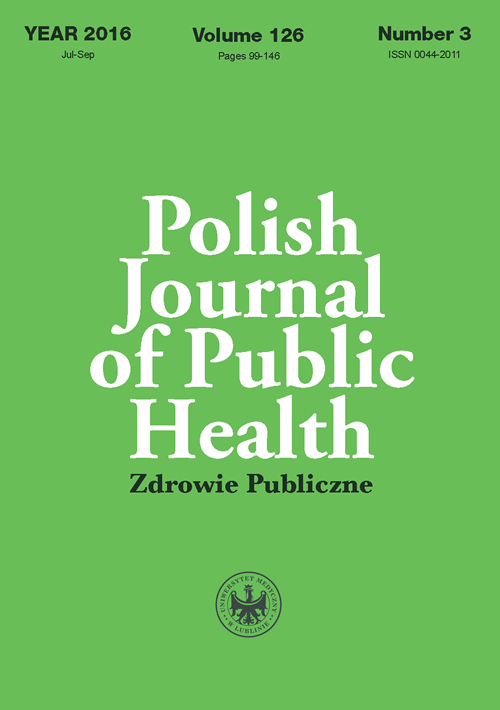A comparison of anterior teeth color among Polish, Saudi and Taiwanese students of dentistry
DOI:
https://doi.org/10.1515/pjph-2016-0028Keywords:
tooth color, spectrophotometer, ethnicity, gender, anterior teethAbstract
Introduction. Color of teeth is undoubtedly one of the most important factors considering patients’ satisfaction with the quality of their restoration, especially in the anterior region of the mouth. Therefore, the determination of color is an integral part of esthetic dentistry and therefore it should be given the highest importance in dentistry in order to achieve the esthetic requirements of patients.
Aim. The aim of this study was to evaluate tooth color in 3 different ethnic groups and its relationship with gender and type of tooth using a clinical spectrophotometer.
Material and methods. A total of 90 dental students of the Medical University of Lublin was divided into three groups of 30 each according to participant’s ethnicity, which was as follows: Polish, Saudi Arabian and Taiwanese. Then, different divisions were made according to gender as well as the type of teeth. The tooth color was identified by spectrophotometer. The data was statistically analyzed.
Results. For the Vita Classical shade guide, A3.5 shade was the most frequently chosen in Taiwanese and Saudi students’ teeth. However, the most common shade observed for the anterior teeth of Polish students was A3. The most common shade among males was A3.5 and in females A3 was the most frequent shade. In all 360 central incisors, overall, the most common shades noticed were A2, D3 and C1. In all 360 lateral incisors, D3, A3 and A2 were the most frequent shades for this group of teeth. In all 360 canines, A3.5 and A3 were the most common shade with almost half of the number of canines in this study was measured with A3.5.
Conclusions. Based on the performed preliminary research, it was observed that Polish students tend to have brighter teeth than Saudis which in turn have even brighter teeth than Taiwanese students. It was also noted that men are more likely to have darker shade values than women. Central incisors have higher values of tooth color than lateral incisors and canines.
References
1. Gómez-Polo C, Gómez-Polo M, et al. Differences between the human eye and the spectrophotometer in the shade matching of tooth colour. J Dent. 2014;42:742-5.
2. Goldstein RE. Esthetic in Dentistry, 2nd ed. B.C. Decker Inc; 1998.
3. Commission Internationale de l’Eclairage (CIE) Improvement to industrial colour-difference evaluation. Vienna CIE Central Bureau Public; 2001. p. 142.
4. Soratur SH. Essentials of Dental Materials. Jaypee Brothers Medical Publishers Ltd; 2007.
5. Gozalo-Diaz DJ, Lindsey DT, Johnston WM, Wee AG. Measurement of color for craniofacial structures using a 45/0-degree optical configuration. J Prosthet Dent. 2007;97:45-53.
6. van der Burgt TP, ten Bosch JJ, Borsboom PC, Kortsmit WJ. A comparison of new and conventional methods for quantification of tooth color. J Prosthet Dent. 1990;63:155-62.
7. Gómez-Polo C, Gómez-Polo M, Celemín-Viñuela A, Martínez Vázquez De Parga JA. Study of the shade tabs of the toothguide 3D master through cluster analysis. Color Res Appl. 2014;40:194-200.
8. Gómez-Polo C, Gómez-Polo M, Celemín Viñuela, A, Martínez Vázquez de Parga JA. A clinical study relating CIELCH coordinates to the color dimensions of the 3D-Master System in a Spanish population. J Prosthet Dent. 2015;113:185-90.
9. Yap AU, Sim CP, Loh WL, Teo JH. Human-eye versus computerized color matching. Oper Dent. 1999;24:358-63.
10. Sproull RC. Color matching in dentistry. II. Practical applications of the organization of color. 1973. J Prosthet Dent. 2001;86:458-64.
11. Paul SJ, Peter A, Rodoni L, Pietrobon N. Conventional visual vs spectrophotometric shade taking for porcelain-fused-to-metal crowns: a clinical comparison. Int J Period Rest Dent. 2004;24:222-31.
12. Khurana R, Tredwin CJ, Weisbloom M, Moles DR. A clinical evaluation of the individual repeatability of three commercially available color measuring devices. Br Dent J.2007;203:675-80.
13. Kielbassa AM, Beheim-Schwarzbach NJ, Neumann K, Zantner C. In vitro comparison of visual and computer-aided pre- and post-tooth shade determination using various home bleaching procedures. J Prosth Dent. 2009;101:92-100.
14. Lagouvardos PE, Fougia AG, Diamantopoulou SA, Polyzois GL. Repeatability and interdevice reliability of two portable color selection devices in matching and measuring tooth color. J Prosth Dent. 2009;101:40-5.
15. Paul S, Peter A, Pietrobon N, Hammerle CH. Visual and spectrophotometric shade analysis of human teeth. J Dent Res. 2002;81:578-82.
16. Rosenstiel SF, Land MF, Fujimoto J. Contemporary fixed prosthodontics.4th ed. Mosby, St. Louis; 2006. p. 709-39.
17. Park JH, Lee Y, Lim BS. Influence of illuminants on the color distribution of shade guides J Prosthet Dent. 2006;96:402-11.
18. Zhu H, Lei Y, Liao N. Color measurements of 1,944 anterior teeth of people in southwest of China-discreption. Zhonghua Kou Qiang Yi Xue Za Zhi. 2001;36:285-8.
19. Yuan JC, Brewer JD, Monaco EA Jr, Davis EL. Defining a natural tooth color space based on a 3-dimensional shade system. J Prosthet Dent. 2007;98:110-9.
20. Veeraganta SK, Savadi RC, Baroudi K, Nassani MZ. Differences in tooth shade value according to age, gender and skin color: A pilot study. J Indian Prosthodont Soc. 2015;15(2):138-41. doi:10.4103/0972-4052.155035.
21. Jahangiri L, Reinhardt SB, Mehra R, Matheson P. Relationship between tooth shade value and skin color: An observational study. J Prosthet Dent. 2002;87:149-52.
22. Esan TA, Olusile AO, Akeredolu PA. Factors influencing tooth shade selection for completely edentulous patients. J Contemp Dent Pract. 2006;7:80-7.
23. Goodkind RJ, Schwabacher WB. Use of a fiber-optic colorimeter for in vivo color measurements of 2830 anterior teeth. J Prosthet Dent. 1987;58:535-42.
24. Tuncdemir AR, Polat S, Ozturk C, et al. Color differences between maxillar and mandibular incisors. Eur J Gen Dent. 2012;1:170-3.
Downloads
Published
Issue
Section
License
Copyright (c) 2016 Polish Journal of Public Health

This work is licensed under a Creative Commons Attribution-NonCommercial-NoDerivatives 3.0 Unported License.


